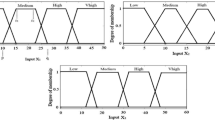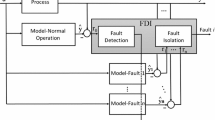Abstract
A complex system in industry is often a conductive flow system. Its abnormal behaviour is difficult to manage due to incomplete and imprecise knowledge on it, also due to propagated effects that appear at faults. Human experts use knowledge from practice to represent abnormal ranges as interval values but they have poor knowledge on variables with no direct link to target system’s goals. The paper proposes a new fuzzy arithmetic, suited to calculate abnormal ranges at test points located far deep in the conductive flow structure of the target system. It uses a semiqualitative encoding of manifestations at faults, and exploits the negative correlation of the power variables (pressure like and flow-rate like) in faulty cases. The method is compared to other approaches and it is tested on a practical case.
Preview
Unable to display preview. Download preview PDF.
Similar content being viewed by others
References
Ariton, V.: Handling Qualitative Aspects of Human Knowledge in Diagnosis. Journal of Intelligent Manufacturing 16(6), 615–634 (2005)
Ariton, V., Palade, V.: Human-Like Fault Diagnosis Using a Neural Network Implementation of Plausibility and Relevance. Neural Comput. & Applic. 14, 149–165 (2005)
Benzecri, D.: La codage linear par morceaux. Les Cahiers de l’Analyse des Donees, XIV, 203-210 (1989)
Cellier, F.E.: Modeling from Physical Principles. In: Levine, W.S. (ed.) The Control Handbook, pp. 98–108. CRC Press, Boca Raton (1995)
Kruse, R.J., et al.: Foundations of fuzzy systems. John Willey & Sons, West Sussex (1994)
Kuipers, B.J.: Qualitative reasoning: modelling and simulation with incomplete knowledge. MIT Press, MA (1994)
Siler, W.: Fuzzy Reasoning - A New Software Technology. PC AI Theme: Neural Networks and Fuzzy Logic 9(2), 22–38 (1995)
Turksen, B.: Fuzy logic and the approximate reasoning. Fuzzy sets and Artificial Intelligence 2, 3–32 (1993)
Author information
Authors and Affiliations
Editor information
Editors and Affiliations
Rights and permissions
Copyright information
© 2006 Springer-Verlag Berlin Heidelberg
About this paper
Cite this paper
Ariton, V. (2006). Semi-qualitative Encoding of Manifestations at Faults in Conductive Flow Systems. In: Gabrys, B., Howlett, R.J., Jain, L.C. (eds) Knowledge-Based Intelligent Information and Engineering Systems. KES 2006. Lecture Notes in Computer Science(), vol 4252. Springer, Berlin, Heidelberg. https://doi.org/10.1007/11893004_74
Download citation
DOI: https://doi.org/10.1007/11893004_74
Publisher Name: Springer, Berlin, Heidelberg
Print ISBN: 978-3-540-46537-9
Online ISBN: 978-3-540-46539-3
eBook Packages: Computer ScienceComputer Science (R0)




